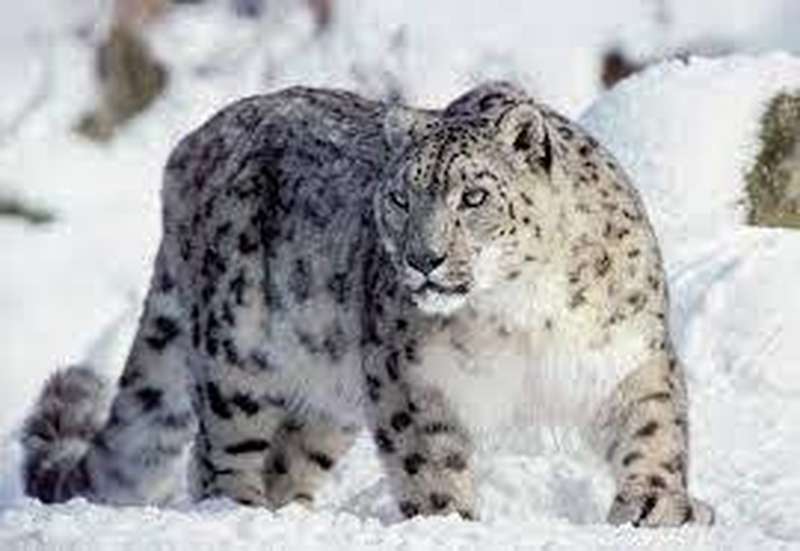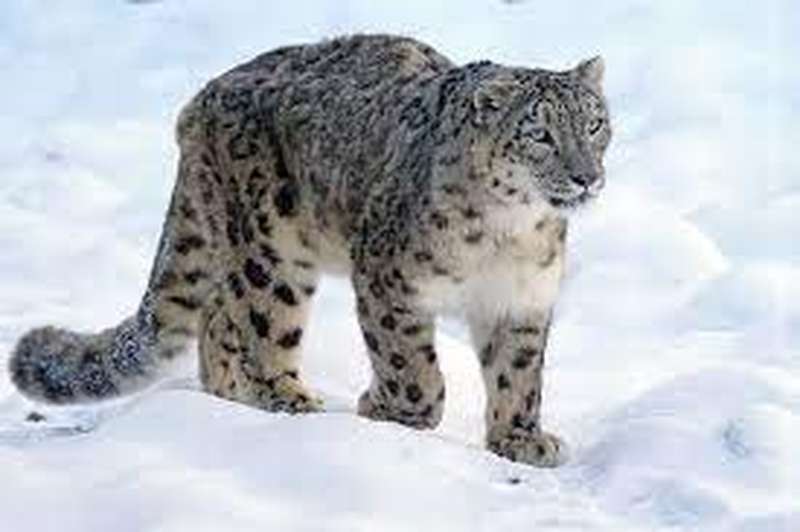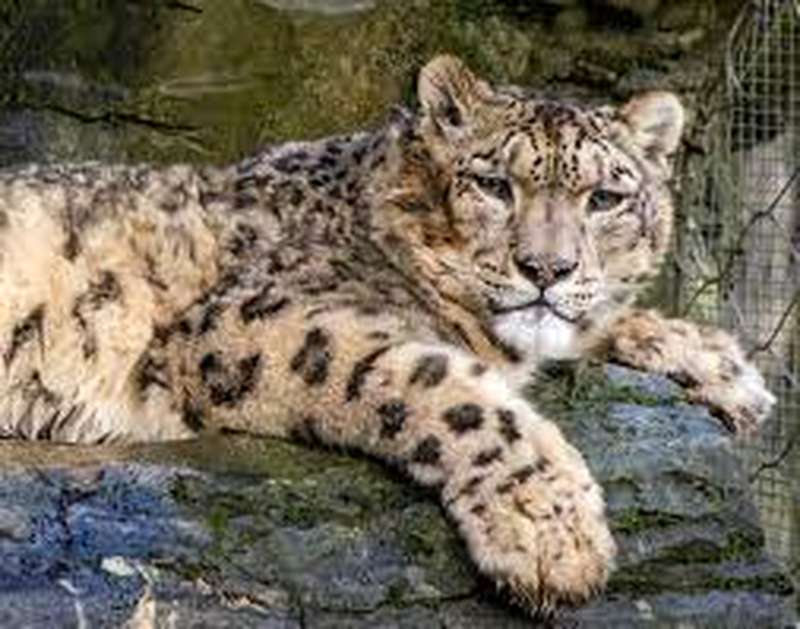Snow leopards are known for their long tails and almost-white coats with giant black rosettes. Snow leopards are disappearing owing to habitat loss, poaching, and climate change.
Snow Leopard
The snow leopard (Panthera uncia), also known as the ounce, is a large cat species belonging to the Panthera genus in the Felidae family.

This species is indigenous to the mountain ranges of Central and South Asia. The species is classified as Vulnerable on the IUCN Red List because its global population is estimated at fewer than 10,000 mature individuals.
Additionally, it is projected to experience a decline of approximately 10% by the year 2040. Its main threats are poaching and habitat destruction caused by infrastructural developments.
The snow leopard can be found in alpine and subalpine zones, specifically at elevations ranging from 3,000 to 4,500 meters (9,800 to 14,800 feet).
Its habitat spans various regions, including eastern Afghanistan, the Himalayas, the Tibetan Plateau, southern Siberia, Mongolia, and western China.
It also inhabits lower elevations in the northern part of its range.
Appearance
The Snow leopard is characterized by its white furry coat with yellow/brownish tinges adorned with rings of brown/black rosettes/spots.
The markings help the animal blend in with its surroundings, making it harder for prey to spot. The fur is woolly and extended, providing excellent protection against extreme cold temperatures.
Their tails are covered in thick fur, and they also have fur on the undersides of their paws to provide protection against cold snow.
The small ears and distinctive heavy brow give the rounded head a unique appearance, especially considering its relatively small size compared to the body.
The leopard’s long tail assists in maintaining balance while navigating through rough and often snowy landscapes.
The powerful limbs of this creature are relatively short compared to its body size. It possesses large and powerful paws.
Distribution

The Snow leopard can be found in a wide range of locations, including the western region of Lake Baikal and southern Siberia.
They are also in the Kunlun, Altai, Sayan, and Tannu-Ola Mountains. Additionally, they inhabit the Tian Shan region, Tajikistan, Kyrgyzstan, Uzbekistan, and Kazakhstan.
They can also be found in the Hindu Kush region in eastern Afghanistan, the Karakoram region in northern Pakistan, and the Pamir Mountains.
Furthermore, Snow leopards can be seen in the Tibetan Plateau and the high elevations of the Himalayas, spanning across India, Nepal, and Bhutan. During summer, the Snow leopard typically resides above the tree line, specifically in alpine meadows and rocky areas.
However, in the winter months, it migrates to lower elevations.
The animal prefers rocky and broken terrain, and it can move through snow as deep as 85 cm (33 in). However, it tends to favor using existing trails created by other animals.
Here are some fascinating details on snow leopards.
The endangered snow leopard (Panthera uncia) is renowned worldwide for its stunning fur and elusive nature. It primarily inhabits the rugged mountains of Central Asia.
Snow leopards possess remarkable adaptations that enable them to thrive in their high-altitude habitat’s frigid and desolate terrain.
However, the existence of these magnificent creatures has become increasingly uncertain due to various human threats.
Despite covering an extensive area of over 2 million km2, scientists estimate that the population of snow leopards in the wild is relatively small, with only an estimated range of 3,920 to 6,390 individuals remaining.

- As a solo traveler, it is worth noting that the snow leopard is known for its solitary nature and remarkable elusiveness.
- Crepuscular animals like cats are most active during dawn and dusk.
- Snow leopards are known to have expansive home ranges, with some individuals occupying areas as large as 1,000 square kilometers.
- Single mothers: for approximately 18 months, female individuals independently raise their offspring.
- The snow leopard primarily inhabits arid and barren mountain areas characterized by cold and dry conditions.
- Snow leopards are generally not known for displaying aggression towards humans.
- The cat primarily preys on ibex, argali, and blue sheep, as it is a carnivorous animal.
Physical characteristics
Snow leopards possess remarkable adaptations that enable them to thrive in their frigid, high-altitude mountainous habitat.
The snow leopard’s thick fur is adorned with dark rosettes and spots, which create a unique pattern for each individual.
This pattern serves as excellent camouflage in their rocky habitat, enabling them to approach their prey stealthily.
Their beautiful coats consist of long hairs with a dense, woolly underfur that serves as protection against the cold.
Snow leopards possess longer tails compared to other large feline species. Leopards can have tails that measure up to 1 meter in length, which aids them in maintaining balance on steep and rocky slopes.
Additionally, leopards can use their tails to provide extra protection against the cold by wrapping them around themselves while they are resting.
Why do they matter?
This extraordinary species, which ranges from Bhutan to China, plays a critical function as a top predator and a gauge of the health of its high-altitude habitat.
The thriving of snow leopards is crucial not only for countless other species but also for the millions of people whose livelihoods depend on the rivers flowing down from Central Asia’s mountains.
Snow leopards are solitary and elusive creatures that typically engage in hunting during the periods of dawn and dusk. Stealthy predators possess the ability to kill prey up to three times their own weight.
Snow leopards primarily prey on herbivores, including blue sheep, Argali sheep, and ibex.
However, snow leopards often hunt livestock in various regions, which leads to conflicts with herders.
Snow leopards’ habitat is crucial for local communities as it offers a range of valuable resources.
These resources include food and medicine, grazing areas for livestock, and wood for shelter, heating, and fuel, in addition to serving as water sources for millions of people downstream.
Population
Threats to the population
The snow leopard is classified as an endangered species on the International Union for Conservation of Nature’s (IUCN) Red List of threatened species.
The snow leopard’s coat is in high demand, leading to illegal hunting for this purpose. Traditional Asian medicine utilizes various body parts and bones for medicinal purposes.
Climate change poses an additional threat to this species as it leads to habitat shifts, fragmentation, and loss.
This species specifically requires a significant amount of space for its habitat.
Ecological Habitat
Snow leopards are crucial for maintaining biodiversity within their ecosystem.
They play an essential role in regulating populations of species lower down on the food chain and serve as a critical indicator of the overall health of their environment.
Indicator species or flagship species can be observed as a means to motivate the public to support the conservation of high-altitude ecosystems.
Protecting the habitats of snow leopards will result in the protection of habitats for numerous other species as well.
Habits and lifestyle
Snow leopards are primarily active during the periods of dawn and dusk. They are highly mobile, frequently changing locations on a daily basis and often relocating their resting site throughout the day.
Typically, they spend several weeks in a specific area of their home range before transitioning to another. Except during the mating season, leopards are mostly solitary creatures.
They intentionally avoid each other by marking travel routes with feces, scrapes, and aromatic scent sprays. Snow leopards are skilled hunters that actively pursue their prey.
The velocity from their initial leap allows them to travel up to 300 meters (980 feet) when chasing animals down steep mountainsides.
These massive hunters use vocalizations such as meowing, grunting, prusten, and moaning to communicate.
In addition, they can purr while exhaling.
The main threats.
Snow leopards are currently confronted with various threats, such as habitat loss, poaching, and escalating conflicts with local communities. Climate change is presently posing an even more significant threat to the future of their mountain home.
Poaching:
Snow leopards have been hunted for their exquisite fur for a considerable period of time.
Additionally, their bones and various other body parts are sought after for their use in Traditional Asian Medicine.
There is evidence suggesting that the illegal trade in snow leopard parts is on the rise.
Community Conflicts:
In some cases, herders resort to killing snow leopards as a form of retaliation when these magnificent creatures attack their livestock.
The leopard’s reliance on livestock for food is increasing due to various factors such as hunting, competition from growing livestock herds, and habitat loss.
This decline in their natural prey is also leading to a higher risk of retaliatory killings.
Downsizing the house:
Snow leopards require extensive areas in order to thrive; however, their habitat is being increasingly encroached upon by expanding human and livestock populations.
Additionally, the construction of new roads and mines is causing further fragmentation of their already limited habitat.
Changing weather patterns:
The impact of climate change on the delicate mountain environment will worsen all these threats, further endangering the future of snow leopards.
Furthermore, this situation poses a significant threat to the well-being and economic stability of local communities and the millions of individuals residing downstream of these crucial watersheds.
Here are some fun facts:
- The snow leopard possesses a wide nose that serves the purpose of warming cold air before it is inhaled into its lungs.
- Snow leopards are capable of making various sounds, such as mewing, growling, and puffing. However, they are unable to roar.
- Adult snow leopards typically lead solitary lives, although young siblings may engage in cuddling and playful activities together.
- Snow leopards possess robust legs, enabling them to execute impressive jumps spanning up to 50 feet in distance.